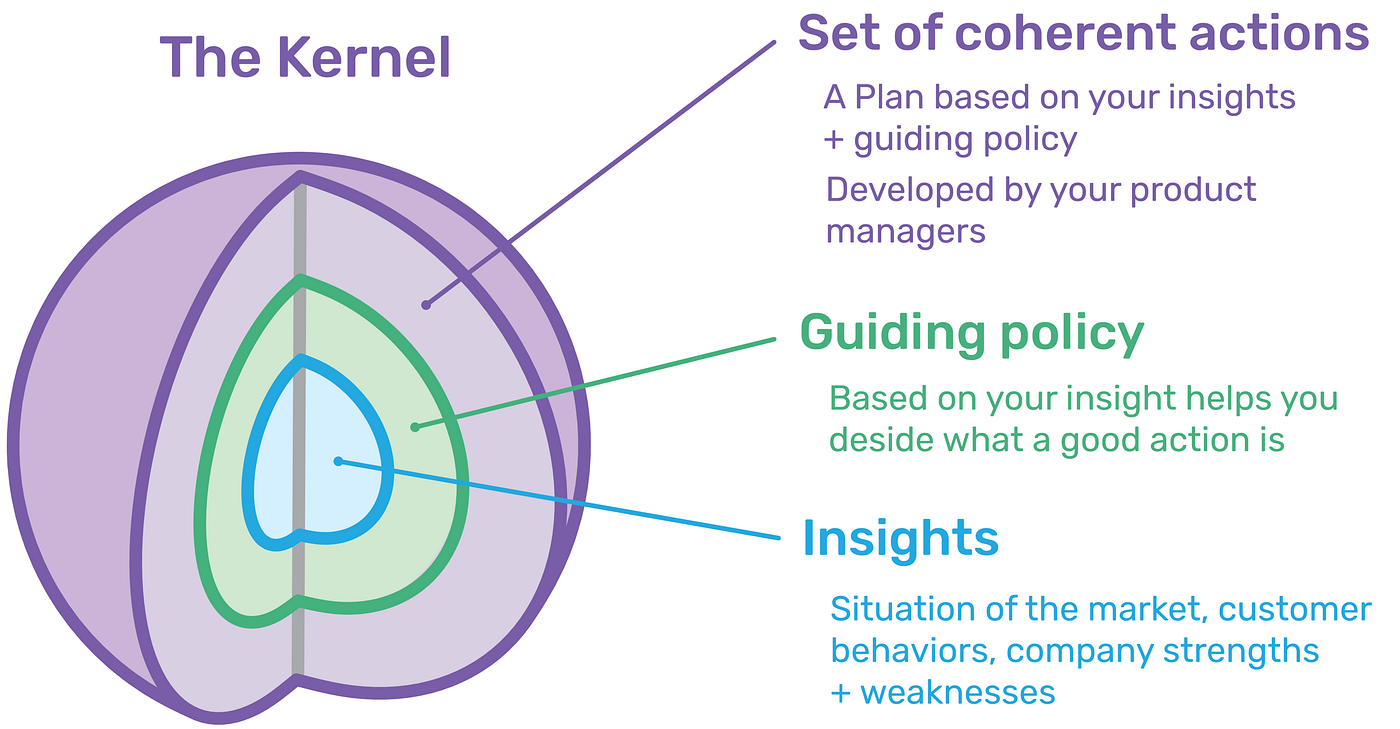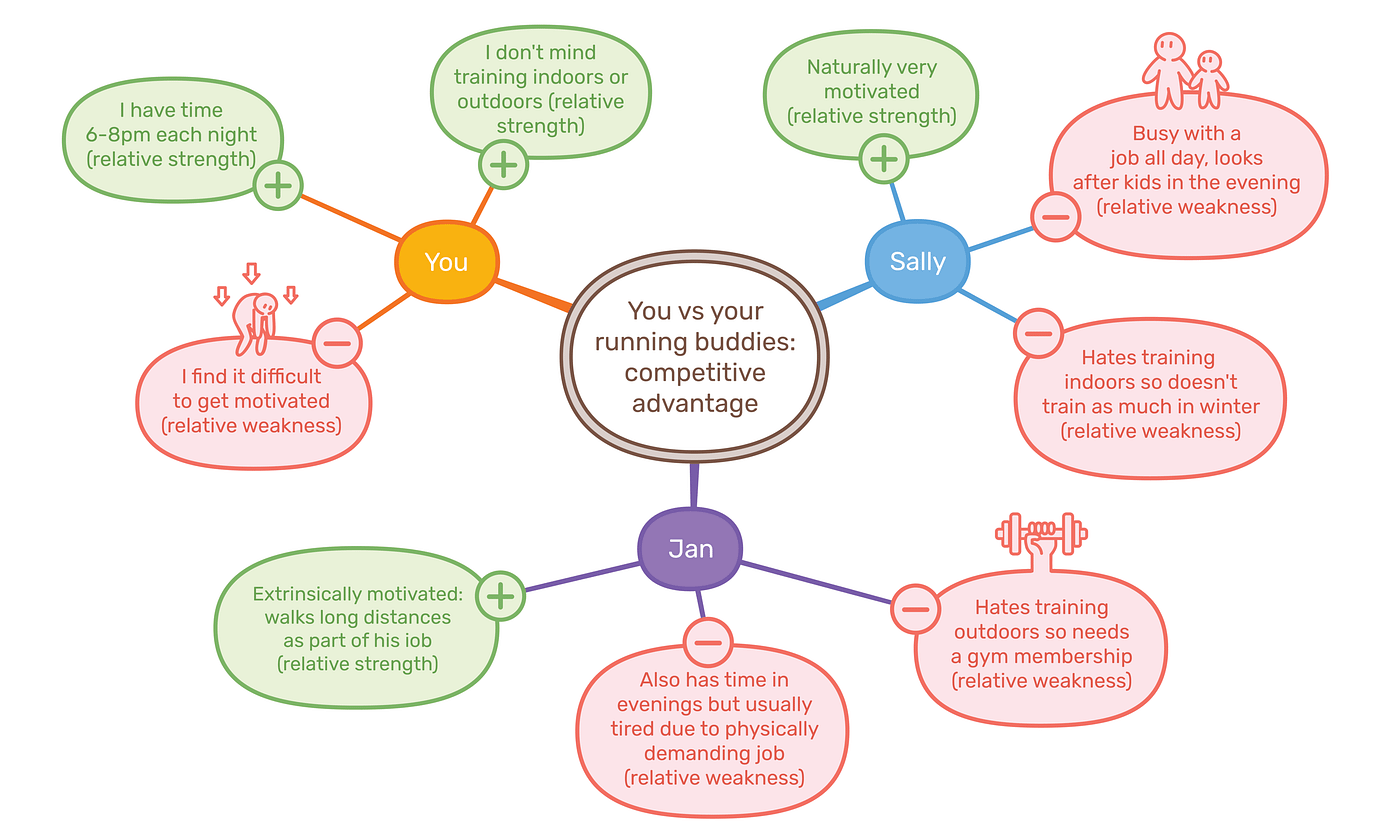[ad_1]
Strategy and enabling your team to solve problems makes the difference between a boss and an impactful leader. In this series, I look at what I wish I had known when I started as Head of Product…
- Understanding strategy allows you to effectively delegate, motivate and align so you can move from a nice boss to an effective leader.
- Without well-researched facts that are based on reality for your company and customers (insights), you won’t make good decisions.
- There’s no separate ‘product strategy’ from company strategy — strategy needs to be cross-departmental.
- Using the ‘Kernel’ from Richard Rumelt’s ‘Good Strategy/Bad Strategy’, specifically insights and developing a guiding policy allows you to enable your team and avoid micro-managing.
When I started as a Head of Product, we were working with a strategist. He asked quite innocently in front of my new team, “what’s the product strategy?” I flustered, probably went bright red, and said “well, you know, grow, I suppose.” It was clear that I didn’t understand strategy and its place in managing people and executing.
“Our strategy is to succeed.” How often have you heard similarly meaningless ‘strategies’ presented to you? Or long to-do lists presented as the new ‘strategic direction’?
Strategies that are fluffy or overly prescriptive dressed up as the next big thing lead to staff being uninspired, leading to poor management practices like micromanaging, or the opposite where people work in an undirected fashion, beavering away on individual topics that sound like a good idea but together they don’t make a meaningful difference to the company’s outcome.
Managers who are able to clearly articulate what a strategy is, the differences between strategy, goals and actions are better able to manage people, build trust with leadership and achieve better outcomes.
What we need is a way to thinking of strategy and clearly define how to work with our peers across the organization and how we empower, direct and explain to those we manage.
Leadership’s primary responsibility is to ensure everyone at a company is able to act with autonomy to bring the company towards its goals.
Everyone at work is constantly making decisions.
To get the best from your and their time, it needs to be clear what a good decision is. A good decision leads to a good action and a good action is will have the highest chance to bring the company towards its goals.
Leadership’s role is to set a framework (or guiding policy) to allow for good decisions and therefore good actions.
This leaves a core question: what is good?
Simply put, these need to be based in reality:
- Reality for your industry (market trends)
- Reality for your company (financing, product performance, resourcing)
- Reality most importantly for your customers (their behaviors, jobs to be done, etc).
These facts come together to form insights which direct your policy and show you what a good decision is.
What’s more, really great strategies use these insights to identify difficult-to-replicate capabilities of your company and apply it to gaps in your market.
In his excellent book ‘Good Strategy / Bad Strategy,’ Richard Rumelt brought these concepts together to form the ‘kernel’ to visualize and separate the different aspects that form good strategy.

One of the most difficult aspects of product leadership is knowing how to give the appropriate level of responsibility to enable a team to do its best work, but also move in one direction to show good outcomes. By dividing each ‘layer’ of the kernel we can start seeing the responsibilities of those around us and the people we manage.
Let’s say that my ambition (goal) is to run a marathon next spring within 5 hours, I could just simply set my actions as running 10k each day, every day, but is this realistic?
Maybe for someone, but not for me. I need a more nuanced plan based on who I am and my current situation.
The ‘who I am’ and ‘current situation’ are our insights. For me personally:
- I find it difficult to get motivated — I therefore train less than I would like. I think I need to train twice as often as I do.
- My time is limited — I only have times after work but before dinner (6–8pm)
- I can workout anywhere — Unlike my friends, I don’t mind if I work out indoors or outdoors.
From here, we can switch these around to guiding policies, which tell us if an action is suitable for us:
- I need types of training that double the chance that I workout.
- I need training that can take place between 6–8pm.
- I can train indoors or outdoors.
Finally, we can think of actions that we can argue against these policies.
After some simple thoughts we can see:
Possible Action 1:
- Idea: Join an evening running group
- Why? Other people to motivate you, takes place in the evening.
Possible Action 2:
- Idea: Get a personal trainer at the gym
- Why? Personal trainer holds you to account, can take place anytime, the extra spending motivates you to use the trainer.

In your job (Head of Product), actions would be the responsibility of your Product Managers, Design and Engineers. They’re the ones who need to work out the problems to solve and ultimately deliver suitable solutions.
You can use your insights to give an idea on your strengths and weaknesses vs your competitors.

A good strategy involves building on your strengths. Here we can see that your competitors although more motivated, have less time or are more picky about where they train. A good action will work towards these strengths and mitigate the weaknesses.
“Extending a competitive advantage requires looking away from products, buyers, and competitors and looking instead at the special skills and resources that underlie a competitive advantage. In other words, “Build on your strengths.””
Richard Rumelt, Good Strategy/Bad Strategy
As Head of Product, you’ll be asked what your ‘strategy is’. It will be expected that you can sum this up in a sentence or two.
Here’s how we can talk about our marathon training…
“I will complete the marathon next spring within 5 hours by training with a personal trainer at 6pm twice a week, ensuring I remain motivated and at a time that fits my schedule.”
You can continue….
“Unlike my competitors, I’m can always commit to my times twice a week.”
The job of a Head of Product is (a) to work with the leadership team and (b) to delegate effectively to the product managers.
Insights, policy and actions neatly fall into different responsibilities in your organization:

Less mature companies often struggle with insights to the detriment of their strategies and outcomes.
I work with companies, often founder-led, who are between 50 and 500 people. Ideas have usually originated from the founder, who often has good (but ageing) insights into the market and customers gained through the first years of selling to these customers directly.
In early-stage start-ups, fast execution and good customer management is key. The priority is on hiring people to execute, coming at the cost of capacity for collecting and structuring customer and market insights. As the company grows, new staff don’t have these insights and there’s often no system to capture and organize them.
The result is people working on something but what they’re working on isn’t well-founded and doesn’t solve customers problems nor a market need.
My recommendations if your company has poor strategy and you feel this is because of limited insights:
- Evaluate the impact of the last 6 months’ developments — what strategic outcome did this support? What was the impact? How do we know whether this worked or not? If you see poor value, you have a good business case to take to leadership on changing things.
- Interview the staff with the longest tenures — founders and long-tenured staff will offer a good perspective on customers and the market.
- Run user surveys and interviews — really the number one here. Start by getting your Product Managers out meeting customers and running surveys. Partner with marketing to help organise surveys and getting access to customers.
I help start ups grow to create fantastic products for their customers. I work with owners, leadership and staff to structure, improve strategy, planning and execution. See my LinkedIn page.
[ad_2]
Source link









